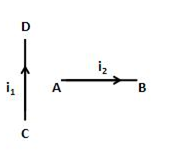 Multiple Choice Questions
Multiple Choice QuestionsWhich of the following is true regarding diamagnetic substaces symbols ( symbols have their usual meaning)
μ > 1, χm > 1
μ > 1, χm < 1
μr < 1, χm < 1
μ >1, χm < 1
Assertion: The magnetic poles of earth do not coincide with the geographic poles.
Reason: The discrepancy between the orientation of a compass and true north-south direction is known as magnetic declination.
If both assertion and reason are true and reason is the correct explanation of assertion.
If both assertion and reason are true but reason is not the correct explanation of assertion.
If assertion is true but reason is false.
If both assertion and reason are false.
A current I1 carrying wire AB is placed near another long wire CD carrying current I2. If wire AB is free to move, it will have

rotational motion only
translational motion only
rotational as well as translational motion
neither rotational nor translational motion
Assertion: Magnetic susceptibillity is a pure number.
Reason: The value of magnetic susceptibility for vacuum is one.
If both assertion and reason are true and reason is the correct explanation of assertion
If both assertion and reason are true but reason is not the correct explanation of assertion
If assertion is true but reason is false
If both assertion and reason are false.
Assertion: We cannot think of magnetic field configuration with three poles.
Reason: A bar magnet does exert a torque on itself to its own field.
If both assertion and reason are true and reason is the correct explanation of assertion
If both assertion and reason are true but reason is not the correct explanation of assertion
If assertion is true but reason is false
If both assertion and reason are false
Assertion: The energy of charged particle moving in a uniform magnetic field does not change.
Reason: Work done by magnetic field on the charge is zero
If both assertion and reason are true and reason is the correct explanation of assertion
If both assertion and reason are true but reason is not the correct explanation of assertion
If assertion is true but reason is false
If both assertion and reason are false
Assertion: Diamagnetic materials can exhibit magnetism.
Reason: Diamagnetic materials have permanent magnetic dipole moment.
If both assertion and reason are true and reason is the correct explanation of the assertion
If both assertion and reason are true but reason is not the correct explanation of the assertion
If assertion is true, but reason is false
Both assertion and reason are false statements.
D.
Both assertion and reason are false statements.
Some materials when placed in an external magnetic field, acquire a very low magnetism in a direction opposite to the field. These materials when brought near the end of a strong magnet, they get repelled. These materials are diamagnetic and this property of materials is called diamagnetism. This property is generally found in materials in which there are even number of electrons in their atoms ( or molecules ) and pairs are formed with two electrons. In each pair, the spin of one electron is in direction opposite to the spin of other electron. Hence, the electrons of each pair completely cancel the magnetic moment of each other. Thus, the net magnetic moment of each atom of such material is zero. Hence, option (c) is true.
